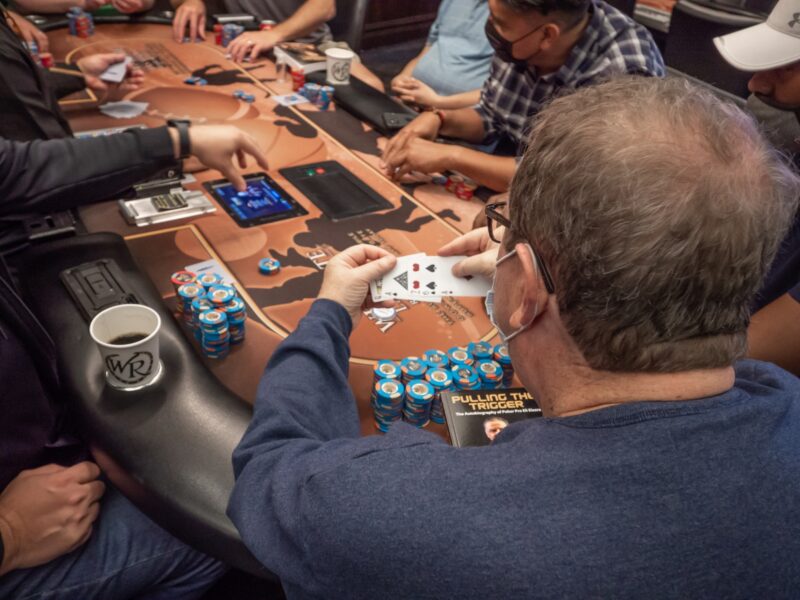Big O, the short name for five-card Omaha high-low eight or better (you can see why it was shortened to Big O), is growing in popularity. Many big bet mixed games have added it to the mix because of the action it generates. This is more and more common with mixed games, adding more cards to a game that already exists in order to stimulate some action and give players more ways to make a hand.

Beware of this trap though. Much like the super stud games and pineapple, the reason that the strong players want these games in the mix is because weaker players tend to play far too many hands and get into trouble. It is easy to overplay a weak hand in Big O if you are used to playing the four-card version.
The Rules
Just like in any Omaha variant, you must use two, and only two, cards from your hand. If there are four diamonds on board, and you only have one diamond, you do not have a flush. It helps beginners to think about which two cards they are playing first, rather than which board cards can work with their hand.
And like any eight or better game you must have five cards eight or lower to qualify for the low half of the pot. Combine those two rules and you can see that there must be three low cards on the board for a low to be possible.
The only difference is the fifth card in your hand, but it is a bigger difference than you might think. The nuts will actually be in play much more often will all the extra combinations, and the nut low with multiple redraws is also a common hand. If the board contains three low cards a showdown with no low present will be rare, especially in multi-way pots.
So, each player gets five cards to start the hand, then a round of betting ensues. There is a flop and a bet, a turn and a bet, and a river and a bet, just like in holdem or Omaha. At the end, players still have five cards and must use two of them to make their best high hand, and two others (they can be the same or different), to make their best low hand if they have a qualifying low.
Preflop Big O Strategy
The first thing you’ll need for your hand to be playable, is an amazing Omaha high-low hand. If you wouldn’t be really excited to play four of the cards in your hand in a regular O/8 game, then it is probably worthless in Big O.
You also want a hand that can win both ways. And winning often means making the nuts in Big O. Any flush less than ace-high may cost you money more often than it wins. Medium pairs also aren’t very valuable, and any pair less than aces is probably garbage. Even aces isn’t all that strong in a multi-way pot since your opponents probably have the other two aces and one pair isn’t a strong hand.
Beginners should usually be looking for hands that include A-2 and some other low cards. An 8, or even a 7, is not very helpful in either direction, so you are looking for cards that are six and lower and aces. Any card that is not one of those, or a king or a queen, is probably a negative for your hand.
The king or queen may not seem all that valuable, but the amount of extra equity it adds against most other playable Big O hands is big enough to make a hand playable. A346K is fine, A346J is barely worth stealing with until you are very comfortable playing post flop.
In pot-limit games you should probably only reraise with good aces and your strongest A23 hands. In fixed-limit games you can reraise wider because there is a lot of value in knocking out the blinds who have five cards to beat you with if you let them in for one bet.
Playing Big O Flops
The flop is the real turning point in Big O, even more so than in other flop games. You will know where your hand is headed most of the time after the flop and will be able to make decisions about how much money you really want to put in. If you put in a pot-sized bet on the flop, you will often be committed on the turn, so in many hands the money goes in on the flop, or the bettor wins when everyone folds.
If you have flopped a draw, it should be a draw you are really excited about. You should be able to picture opponents with hands that seem good who are in big trouble against you. If you flop an eight-out straight draw, don’t even consider it to be a serious draw. You are much too likely to be dominated by a bigger draw with twelve or more outs and your opponent will freeroll you for a huge pot.
If you have a low draw, it should usually be to the nut low. Second nut low draws are very expensive in Big O, and new players lost a lot of their money on them. Drawing to a non-nut low is fine if you have a ton of other things going on. If you add a nut flush draw and a low straight draw to your weak low draw, it may still be quite strong.
Drawing to semi-strong hands both ways can also be very troublesome. If you have the second nut flush draw and the second nut low draw, you should get part of the pot most of the time right? Wrong. Because your opponents hold nut draws so much more often in the five-card game. You could be drawing virtually dead and piling in chips you will never get back.
Playing The Turn
The turn is really just a continuation. If you liked your hand on the flop, then you probably like it now unless something has changed that makes your hand vulnerable. You should give up on straight and flush draws if the board pairs and you don’t have anything else to go with your high draws because your opponent is very likely to have a full house. The same is true with straight draws when a third flush card hits. Don’t draw if you may be drawing dead and have to put any real money in the pot.
If you have the nuts, keep betting. Your opponent probably has a lot of outs and you want to charge them as much as possible on every street, especially if you don’t have a redraw to make the same hand they are drawing to. When in doubt, bet your monsters.
Playing The River
It’s best to keep your value bets to times when you have the nuts at least one way until you are a bit more experienced. Betting a second nut hand can put you in a tough spot when you get reraised and your opponent might only have the nuts in one direction and not much going the other way. When they make that big raise, it puts you in a tough spot and you will make mistakes.
Final Thoughts
Big O can bring big swings, so play smaller than you usually would. And remember that your bluffs will not work very often, so you are playing a game of showing down the best hand. Play hands that can make the nuts, but them when you get them and fold when you don’t have a very strong hand, and you should be okay until you get a good feel for the game and can start making moves.
Remember that any hand without an ace and a deuce better have everything else working for it and it better be cheap to see a flop, because making the nut low is so valuable.


